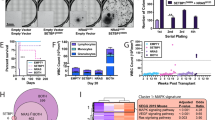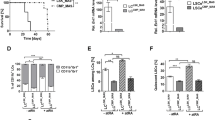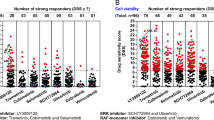Abstract
Retinoic acid (RA) has broad clinical applications for the treatment of various cancers, particularly acute promyelocytic leukemia. However, RA-based therapy is limited by relapse in patients associated with RA resistance, the mechanism of which is poorly understood. Here, we suggest a new molecular mechanism of RA resistance by a repressor, named RA resistance factor (RaRF). RaRF suppressed transcriptional activity of the RA receptor (RAR) by directly interacting with and sequestering RAR to the nucleolus in response to RA. RaRF was highly expressed in RA-resistant leukemia cells and its expression was strongly correlated with RA sensitivity. MCL1 was upregulated by RA treatment upon RaRF depletion, accompanying leukemic myeloblast differentiation, which is negatively regulated by ectopic RaRF expression. Collectively, we propose that RaRF may be a factor in the resistance mechanism and thus a potential target for leukemia therapy using RA.
This is a preview of subscription content, access via your institution
Access options
Subscribe to this journal
Receive 50 print issues and online access
$259.00 per year
only $5.18 per issue
Buy this article
- Purchase on Springer Link
- Instant access to full article PDF
Prices may be subject to local taxes which are calculated during checkout






Similar content being viewed by others
References
De Luca LM . Retinoids and their receptors in differentiation, embryogenesis, and neoplasia. FASEB J 1991; 5: 2924–2933.
Chambon P . The molecular and genetic dissection of the retinoid signaling pathway. Recent Prog Horm Res 1995; 50: 317–332.
Bushue N, Wan YJ . Retinoid pathway and cancer therapeutics. Adv Drug Deliv Rev 2010; 62: 1285–1298.
Tang XH, Gudas LJ . Retinoids, retinoic acid receptors, and cancer. Annu Rev Pathol 2011; 6: 345–364.
de The H, Lavau C, Marchio A, Chomienne C, Degos L, Dejean A . The PML-RAR alpha fusion mRNA generated by the t(15;17) translocation in acute promyelocytic leukemia encodes a functionally altered RAR. Cell 1991; 66: 675–684.
Lin RJ, Sternsdorf T, Tini M, Evans RM . Transcriptional regulation in acute promyelocytic leukemia. Oncogene 2001; 20: 7204–7215.
Grignani F, Fagioli M, Alcalay M, Longo L, Pandolfi PP, Donti E et al. Acute promyelocytic leukemia: from genetics to treatment. Blood 1994; 83: 10–25.
Hung ME, Ye YC, Chen SR, Chai JR, Lu JX, Zhoa L et al. Use of all-trans retinoic acid in the treatment of acute promyelocytic leukemia. Blood 1988; 72: 567–572.
Warrell RP Jr., de The H, Wang ZY, Degos L . Acute promyelocytic leukemia. N Engl J Med 1993; 329: 177–189.
Degos L, Dombret H, Chomienne C, Daniel MT, Miclea JM, Chastang C et al. All-trans-retinoic acid as a differentiating agent in the treatment of acute promyelocytic leukemia. Blood 1995; 85: 2643–2653.
Freemantle SJ, Spinella MJ, Dmitrovsky E . Retinoids in cancer therapy and chemoprevention: promise meets resistance. Oncogene 2003; 22: 7305–7315.
O'Malley B . The Year in Basic Science: nuclear receptors and coregulators. Mol Endocrinol 2008; 22: 2751–2758.
Gurevich I, Flores AM, Aneskievich BJ . Corepressors of agonist-bound nuclear receptors. Toxicol Appl Pharmacol 2007; 223: 288–298.
Andersen JS, Lam YW, Leung AK, Ong SE, Lyon CE, Lamond AI et al. Nucleolar proteome dynamics. Nature 2005; 433: 77–83.
Boisvert FM, van Koningsbruggen S, Navascues J, Lamond AI . The multifunctional nucleolus. Nat Rev Mol Cell Biol 2007; 8: 574–585.
Pederson T, Tsai RY . In search of nonribosomal nucleolar protein function and regulation. J Cell Biol 2009; 184: 771–776.
Olson MO . Sensing cellular stress: another new function for the nucleolus? Sci STKE 2004; 224: pe10.
Lindstrom MS . Emerging functions of ribosomal proteins in gene-specific transcription and translation. Biochem Biophys Res Commun 2009; 379: 167–170.
Warner JR, McIntosh KB . How common are extraribosomal functions of ribosomal proteins? Mol Cell 2009; 34: 3–11.
Berghofer-Hochheimer Y, Zurek C, Wolfl S, Hemmerich P, Munder T . L7 protein is a coregulator of vitamin D receptor-retinoid X receptor-mediated transactivation. J Cell Biochem 1998; 69: 1–12.
Schulz M, Schneider S, Lottspeich F, Renkawitz R, Eggert M . Identification of nucleolin as a glucocorticoid receptor interacting protein. Biochem Biophys Res Commun 2001; 280: 476–480.
Lall R, Kuruvilla S, Prufer K . Liver X receptor beta with mutations in the activation function-2 region is excluded from the nucleolus. Cell Biol Int 2009; 33: 447–452.
Gushima M, Kawate H, Ohnaka K, Nomura M, Takayanagi R . Raloxifene induces nucleolar translocation of the estrogen receptor. Mol Cell Endocrinol 2010; 319: 14–22.
Um SJ, Youn H, Kim EJ . Negative regulation of ERRalpha by a novel nucleolar protein. Biochem Biophys Res Commun 2012; 418: 290–295.
Kozopas KM, Yang T, Buchan HL, Zhou P, Craig RW . MCL1, a gene expressed in programmed myeloid cell differentiation, has sequence similarity to BCL2. Proc Natl Acad Sci USA 1993; 90: 3516–3520.
Craig RW . MCL1 provides a window on the role of the BCL2 family in cell proliferation, differentiation and tumorigenesis. Leukemia 2002; 16: 444–454.
Yang T, Buchan HL, Townsend KJ, Craig RW . MCL-1, a member of the BLC-2 family, is induced rapidly in response to signals for cell differentiation or death, but not to signals for cell proliferation. J Cell Physiol 1996; 166: 523–536.
Umezawa A, Maruyama T, Inazawa J, Imai S, Takano T, Hata J . Induction of mcl1/EAT, Bcl-2 related gene, by retinoic acid or heat shock in the human embryonal carcinoma cells, NCR-G3. Cell Struct Funct 1996; 21: 143–150.
Okita H, Umezawa A, Suzuki A, Hata J . Up-regulated expression of murine Mcl1/EAT, a bcl-2 related gene, in the early stage of differentiation of murine embryonal carcinoma cells and embryonic stem cells. Biochim Biophys Acta 1998; 1398: 335–341.
Yang J, Ikezoe T, Nishioka C, Yokoyama A . Over-expression of Mcl-1 impairs the ability of ATRA to induce growth arrest and differentiation in acute promyelocytic leukemia cells. Apoptosis 2013; 18: 1403–1415.
Wang R, Xia L, Gabrilove J, Waxman S, Jing Y . Sorafenib inhibition of Mcl-1 accelerates ATRA-induced apoptosis in differentiation-responsive AML Cells. Clin Cancer Res 2016; 22: 1211–1221.
Um SJ, Youn HS, Kim EJ . De-repression of RaRF-mediated RAR repression by adenovirus E1A in the nucleolus. Biochem Biophys Res Commun 2014; 444: 605–610.
Liu M, Iavarone A, Freedman LP . Transcriptional activation of the human p21(WAF1/CIP1) gene by retinoic acid receptor. Correlation with retinoid induction of U937 cell differentiation. J Biol Chem 1996; 271: 31723–31728.
Hasina R, Pontier AL, Fekete MJ, Martin LE, Qi XM, Brigaudeau C et al. NOL7 is a nucleolar candidate tumor suppressor gene in cervical cancer that modulates the angiogenic phenotype. Oncogene 2006; 25: 588–598.
Um SJ, Han HS, Kwon YJ, Park SH, Rho YS, Sin HS et al. Novel retinoic acid derivative ABPN has potent inhibitory activity on cell growth and apoptosis in cancer cells. Int J Cancer 2003; 107: 1038–1046.
Han HS, Kwon YJ, Park SH, Kim EJ, Rho YS, Sin HS et al. Potent effect of 5-HPBR, a butanoate derivative of 4-HPR, on cell growth and apoptosis in cancer cells. Int J Cancer 2004; 109: 58–64.
Schlenk RF, Germing U, Hartmann F, Glasmacher A, Fischer JT, del Valle y Fuentes F et al. High-dose cytarabine and mitoxantrone in consolidation therapy for acute promyelocytic leukemia. Leukemia 2005; 19: 978–983.
Okada Y, Jiang Q, Lemieux M, Jeannotte L, Su L, Zhang Y . Leukaemic transformation by CALM-AF10 involves upregulation of Hoxa5 by hDOT1L. Nat Cell Biol 2006; 8: 1017–1024.
Oren T, Sher JA, Evans T . Hematopoiesis and retinoids: development and disease. Leuk Lymphoma 2003; 44: 1881–1891.
Sanz MA, Lo-Coco F . Modern approaches to treating acute promyelocytic leukemia. J Clin Oncol 2011; 29: 495–503.
Altucci L, Gronemeyer H . The promise of retinoids to fight against cancer. Nat Rev Cancer 2001; 1: 181–193.
Okuno M, Kojima S, Matsushima-Nishiwaki R, Tsurumi H, Muto Y, Friedman SL et al. Retinoids in cancer chemoprevention. Curr Cancer Drug Targets 2004; 4: 285–298.
Martindill DM, Riley PR . Cell cycle switch to endocycle: the nucleolus lends a hand. Cell Cycle 2008; 7: 17–23.
Mayer C, Grummt I . Cellular stress and nucleolar function. Cell Cycle 2005; 4: 1036–1038.
Gerbi SA, Borovjagin AV, Lange TS . The nucleolus: a site of ribonucleoprotein maturation. Curr Opin Cell Biol 2003; 15: 318–325.
Maruvada P, Baumann CT, Hager GL, Yen PM . Dynamic shuttling and intranuclear mobility of nuclear hormone receptors. J Biol Chem 2003; 278: 12425–12432.
Zhuang J, Brady HJ . Emerging role of Mcl-1 in actively counteracting BH3-only proteins in apoptosis. Cell Death Differ 2006; 13: 1263–1267.
Kaufmann SH, Karp JE, Svingen PA, Krajewski S, Burke PJ, Gore SD et al. Elevated expression of the apoptotic regulator Mcl-1 at the time of leukemic relapse. Blood 1998; 91: 991–1000.
Lee HK, Park UH, Kim EJ, Um SJ . MED25 is distinct from TRAP220/MED1 in cooperating with CBP for retinoid receptor activation. EMBO J 2007; 26: 3545–3557.
Scherl A, Coute Y, Deon C, Calle A, Kindbeiter K, Sanchez JC et al. Functional proteomic analysis of human nucleolus. Mol Biol Cell 2002; 13: 4100–4109.
Acknowledgements
We would like to thank Dr Masahiro Kizaki (Division of Hematology and Clinical Laboratories, Keio University School of Medicine, Japan) and Dr Chi-Dug Kang (Pusan National University School of Medicine, Korea) for providing UF-1 and NB4 cells, respectively. This study was supported in part by a grant from the Korea Food Research Institute (to SJU) and a grant of the Basic Science Research Program through NRF grant (2014R1A2A1A11052685 to SJU and 2016R1D1A1B03931405 to HY), Republic of Korea.
Author information
Authors and Affiliations
Corresponding authors
Ethics declarations
Competing interests
The authors declare no conflict of interest.
Additional information
Supplementary Information accompanies this paper on the Oncogene website
Supplementary information
Rights and permissions
About this article
Cite this article
Youn, H., Lee, HK., Sohn, HR. et al. RaRF confers RA resistance by sequestering RAR to the nucleolus and regulating MCL1 in leukemia cells. Oncogene 37, 352–362 (2018). https://doi.org/10.1038/onc.2017.329
Received:
Revised:
Accepted:
Published:
Issue Date:
DOI: https://doi.org/10.1038/onc.2017.329



